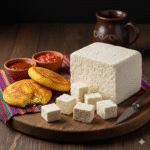When you think of cheese, llama milk may not be the first thing that comes to mind. Yet in the high Andean plains of Bolivia, Queso de Llama has been part of local food traditions for centuries. This rare and culturally rich cheese reflects the landscape, history, and ingredient heritage of the altiplano. If you’re curious about llama cheese, Bolivian cheese, or what makes llama milk cheese so special, this guide covers everything from its origins to tasting notes and substitutes.
What Is Queso de Llama?
Queso de Llama is an artisanal cheese crafted from the milk of llamas—animals that have sustained Andean communities for thousands of years. Unlike cow or goat milk, llama milk is naturally lower in fat but richer in calcium and protein. This gives llama cheese a distinct texture and nutritional profile.
Produced mostly in rural areas of Potosí, Oruro, and the expansive altiplano, Queso de Llama is made in small batches using traditional hand-pressed techniques. Because llamas produce relatively small amounts of milk, the cheese remains scarce and highly valued in local markets.
How Queso de Llama Is Made
The production of llama milk cheese closely follows ancestral methods. After the fresh milk is warmed, natural coagulants are added—often derived from local plants. The curds are then pressed into rustic rounds and left to firm up under the cool, dry Andean climate.
Some varieties are consumed fresh, while others are lightly aged to deepen the flavor. The drying process gives the cheese a firm bite, making it easy to transport and store—an essential attribute for communities living in remote high-altitude areas.
Flavor Profile: What Does Llama Cheese Taste Like?
Queso de Llama has a unique profile that sets it apart from more familiar cheeses.
Tasting Notes
-
Texture: Semi-firm to firm, slightly crumbly
-
Flavor: Mildly salty, earthy, with a delicate tang
-
Aroma: Clean, subtle, with hints of pasture
-
Finish: Smooth, with a light mineral quality from the Andean soil
Compared to cow’s milk cheese, llama cheese feels leaner but more complex. It’s not as sharp as goat cheese and not as buttery as cow-based varieties, making it a wonderfully balanced option for cheese lovers seeking something new.
Traditional Uses in Bolivian Cuisine
Queso de Llama pairs beautifully with the hearty, rustic dishes of the Bolivian altiplano. You’ll often find it served in:
1. Charque de Llama
A traditional dish of sun-dried llama meat served with potatoes, corn, and fresh llama cheese. It’s so iconic that people sometimes search for the best charque de llama near me when traveling across Bolivia.
2. Andean Soups & Stews
Fresh llama cheese melts gently into dishes like chairo, adding creaminess without overwhelming the flavors.
3. Bread & Street Foods
Vendors sell warm flatbreads stuffed with queso de llama, similar to empanadas but with a distinctly Andean twist.
4. Simple Mountain Meals
Locals enjoy the cheese with roasted potatoes, llajwa (a spicy tomato salsa), or quinoa—a staple crop of the region.
Queso de Llama Substitutes
Because authentic queso de llama is hard to find outside Bolivia, cooks often look for replacements. While nothing perfectly matches its lean, earthy profile, these substitutes come close:
-
Aged goat cheese – similar tang and crumble
-
Queso fresco – mild and fresh
-
Feta (low-salt varieties) – firmer texture
-
Ricotta salata – slightly salty and dry
If you’re searching for a queso de llama substitute, opt for cheeses that are not too creamy or sharp.
Where to Find Queso de Llama
Outside Bolivia, Queso de Llama is rare due to limited production. Travelers may find it in traditional markets in:
-
Potosí
-
Oruro
-
La Paz altiplano villages
If you’re researching Bolivian cheese or wondering how to taste authentic queso de llama, your best opportunity is to try it locally during a visit to the Andes.
Final Thoughts
Queso de Llama is more than a regional cheese—it’s a symbol of Bolivia’s Andean heritage. Its clean flavor, nutritious profile, and high-altitude roots make it one of the most unique cheeses in South America. Whether you’re exploring unusual cheeses, seeking llama cheese tasting notes, or looking for a queso de llama substitute, this Bolivian specialty offers a delicious glimpse into traditional Andean life.



